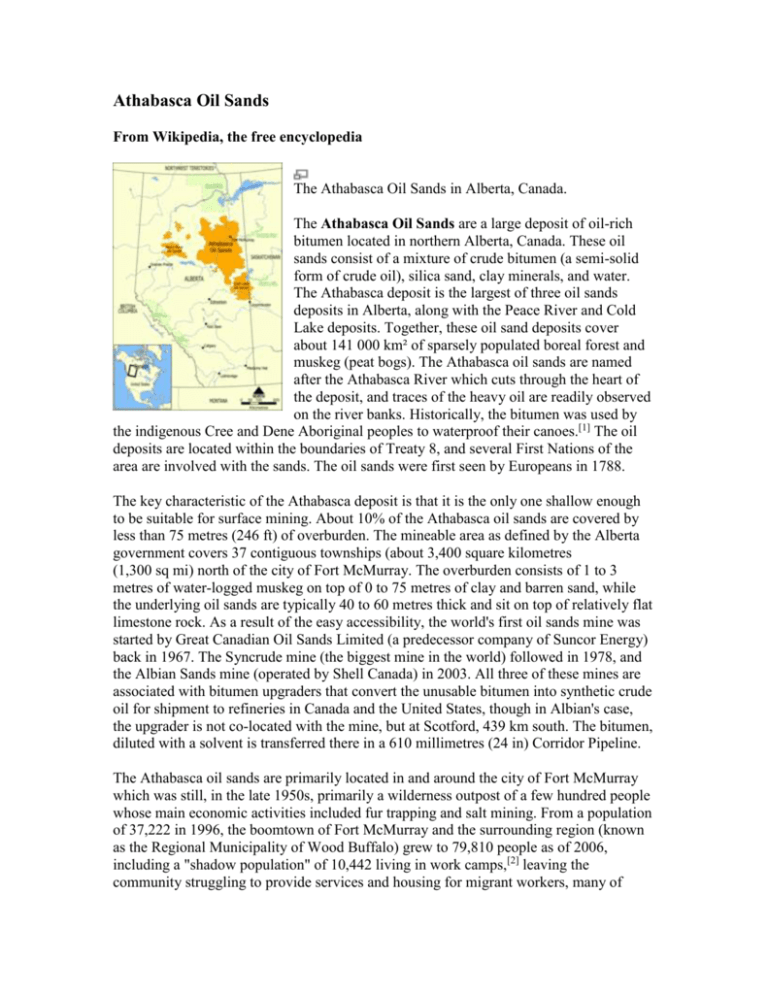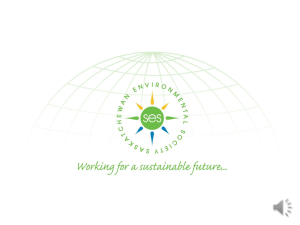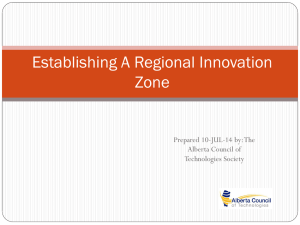Athabasca Oil Sands
advertisement

Athabasca Oil Sands From Wikipedia, the free encyclopedia The Athabasca Oil Sands in Alberta, Canada. The Athabasca Oil Sands are a large deposit of oil-rich bitumen located in northern Alberta, Canada. These oil sands consist of a mixture of crude bitumen (a semi-solid form of crude oil), silica sand, clay minerals, and water. The Athabasca deposit is the largest of three oil sands deposits in Alberta, along with the Peace River and Cold Lake deposits. Together, these oil sand deposits cover about 141 000 km² of sparsely populated boreal forest and muskeg (peat bogs). The Athabasca oil sands are named after the Athabasca River which cuts through the heart of the deposit, and traces of the heavy oil are readily observed on the river banks. Historically, the bitumen was used by the indigenous Cree and Dene Aboriginal peoples to waterproof their canoes.[1] The oil deposits are located within the boundaries of Treaty 8, and several First Nations of the area are involved with the sands. The oil sands were first seen by Europeans in 1788. The key characteristic of the Athabasca deposit is that it is the only one shallow enough to be suitable for surface mining. About 10% of the Athabasca oil sands are covered by less than 75 metres (246 ft) of overburden. The mineable area as defined by the Alberta government covers 37 contiguous townships (about 3,400 square kilometres (1,300 sq mi) north of the city of Fort McMurray. The overburden consists of 1 to 3 metres of water-logged muskeg on top of 0 to 75 metres of clay and barren sand, while the underlying oil sands are typically 40 to 60 metres thick and sit on top of relatively flat limestone rock. As a result of the easy accessibility, the world's first oil sands mine was started by Great Canadian Oil Sands Limited (a predecessor company of Suncor Energy) back in 1967. The Syncrude mine (the biggest mine in the world) followed in 1978, and the Albian Sands mine (operated by Shell Canada) in 2003. All three of these mines are associated with bitumen upgraders that convert the unusable bitumen into synthetic crude oil for shipment to refineries in Canada and the United States, though in Albian's case, the upgrader is not co-located with the mine, but at Scotford, 439 km south. The bitumen, diluted with a solvent is transferred there in a 610 millimetres (24 in) Corridor Pipeline. The Athabasca oil sands are primarily located in and around the city of Fort McMurray which was still, in the late 1950s, primarily a wilderness outpost of a few hundred people whose main economic activities included fur trapping and salt mining. From a population of 37,222 in 1996, the boomtown of Fort McMurray and the surrounding region (known as the Regional Municipality of Wood Buffalo) grew to 79,810 people as of 2006, including a "shadow population" of 10,442 living in work camps,[2] leaving the community struggling to provide services and housing for migrant workers, many of them from Eastern Canada, especially Newfoundland. Fort McMurray itself ceased to be an incorporated city in 1995 and is now an urban service area within Wood Buffalo.[3] Estimated oil reserves Alberta Government calculates that about 28 billion cubic metres (174 billion barrels) of crude bitumen are economically recoverable from the three Alberta oil sands areas at current prices using current technology. This is equivalent to about 10% of the estimated 1,700 and 2,500 billion barrels of bitumen in place.[4] Alberta estimates that the Athabasca deposits alone contain 5.6 billion cubic metres (35 billion barrels) of surface mineable bitumen and 15.6 billion cubic metres (98 billion barrels) of bitumen recoverable by in-situ methods. These estimates of Canada's oil reserves caused some astonishment when they were first published but are now largely accepted by the international community. This volume places Canadian proven oil reserves second in the world behind those of Saudi Arabia. The method of calculating economically recoverable reserves that produced these estimates was adopted because conventional methods of accounting for reserves gave increasingly meaningless numbers. They made it appear that Alberta was running out of oil at a time when rapid increases in oil sands production were more than offsetting declines in conventional oil, and in fact most of Alberta's oil production is now nonconventional oil. Conventional estimates of oil reserves are really calculations of the geological risk of drilling for oil, but in the oil sands there is very little geological risk because they outcrop on the surface and are extremely easy to find. One risk is economic risk of low oil prices and with the oil price increases of 2004-2006, this economic risk evaporated. The Alberta estimates in some ways are extremely conservative, since they assume a recovery rate of around 20% of bitumen in place, whereas oil companies using the new steam assisted gravity drainage (SAGD) method of extracting bitumen report that they can recover over 60% with little effort. These much higher recovery rates probably mean that the ultimate production could be several times as high as the already very large government estimates. At rate of production projected for 2015, about 3,000,000 barrels (~510,000 t) per day, the Athabasca oil sands reserves would last over 400 years.[5] However, production cannot increase to those levels without a huge influx of workers into northern Alberta, which by 2006 was already occurring. This need created a severe labor shortage in Alberta, which by 2007 drove unemployment rates in Alberta and adjacent British Columbia to the lowest levels in history. Even as far away as the Atlantic Provinces, where workers were leaving to work in Alberta, unemployment rates fell to levels not seen for over 100 years.[6] The Venezuelan Orinoco tar sands site may contain more oil sands than Athabasca (see tar sands article). However, while the Orinoco deposits are less viscous and more easily produced using conventional techniques (the Venezuelan government prefers to call them "extra-heavy oil"), they are too deep to access by surface mining. Oil sands production The Athabasca oil sands first came to the attention of European fur traders in 1719 when Wa-pa-su, a Cree trader, brought a sample of the oil sands to the Hudson's Bay Company post at Fort Churchill. In 1719, fur trader Henry Kelsey became the first white man to see the outcroppings along the Athabasca River and he noted that the native people used it to waterproof their canoes.[10] In 1883, C. Hoffman of the Geological Survey of Canada tried separating the bitumen from oil sand with the use of water, and reported that it separated readily. However, it was nearly a century before extracting it became commercially viable. Dr. Karl Clark of the University of Alberta, perfected a steam separation process for the tar sands in 1926. Commercial production of oil from the Athabasca oil sands began in 1967, when Great Canadian Oil Sands Limited (then a subsidiary of Sun Oil Company but now an independent company known as Suncor Energy) opened its first mine, producing 30,000 barrels per day of synthetic crude oil. Development was inhibited by declining world oil prices, and the second mine, operated by the Syncrude consortium, did not begin operating until 1978, after the 1973 oil crisis sparked investor interest. However, the price of oil subsided afterwards, and although the 1979 energy crisis caused oil prices to peak again, introduction of the National Energy Program by Pierre Trudeau discouraged foreign investment in the Canadian oil industry. During the 1980s, oil prices declined to very low levels, causing considerable retrenchment in the oil industry, and the third mine, operated by Shell Canada, did not begin operating until 2003. However, as a result of oil price increases since 2003, the existing mines have been greatly expanded and new ones are being planned. According to the Alberta Energy and Utilities Board, 2005 production of crude bitumen in the Athabasca oil sands was as follows: 2005 Production m3/day bbl/day Suncor Mine 31,000 195,000 Syncrude Mine 41,700 262,000 Shell Canada Mine 26,800 169,000 In Situ Projects 21,300 134,000 TOTAL 120,800 760,000 As of 2006, output of oil sands production had increased to 1.126 million barrels per day (bbl/d). Oil sands were the source of 62% of Alberta's total oil production and 47% of all oil produced in Canada. The Alberta government believes this level of production could reach 3 million bbl/d by 2020 and possibly 5 million bbl/d by 2030.[11] Indigenous peoples of the area Indigenous peoples of the area include the Fort McKay First Nation and the Fort McMurray First Nation. The oil sands themselves are located within the boundaries of Treaty 8, signed in 1899. The Fort McKay First Nation has formed several companies to service the oil sands industry, and will be developing a mine on their territory.[21] Opposition remaining within the First Nation focuses on environmental stewardship issues. Environmental impacts Critics contend that government and industry measures taken to minimize environmental and health risks posed by large-scale mining operations are inadequate, causing damage to the natural environment.[22][23] The open-pit mining of the Athabasca oils sands destroys the boreal forest and muskeg, as well as changing the natural landscape. The Alberta government does not require companies to restore the land to "original condition" but only to "equivalent land capability". This means that the ability of the land to support various land uses after reclamation is similar to what existed, but that the individual land uses will not necessarily be identical.[24] Since the government considers agricultural land to be equivalent to forest land, oil sands companies have reclaimed mined land to use as pasture for buffalo, rather than restoring it to the original boreal forest and muskeg.[citation needed] For every barrel of synthetic oil produced in Alberta, more than 80 kg of greenhouse gases are released[citation needed] into the atmosphere and between 2 and 4 barrels[citation needed] of waste water are dumped into tailing ponds that have replaced about 50 km²[citation needed] of forest. The forecast growth in synthetic oil production in Alberta also threatens Canada's international commitments. In ratifying the Kyoto Protocol, Canada agreed to reduce, by 2012, its greenhouse gas emissions by 6% with respect to [1990]. In 2002, Canada's total greenhouse gas emissions had increased by 24% since 1990. A Pembina Institute report stated "To produce one cubic metre (m³) of synthetic crude oil (SCO) (upgraded bitumen) in a mining operation requires about 2–4.5 m³ of water (net figures). Approved oil sands mining operations are currently licensed to divert 359 million m³ from the Athabasca River, or more than twice the volume of water required to meet the annual municipal needs of the City of Calgary."[25] and went on to say "...the net water requirement to produce a cubic metre of oil with in situ (emphasis added) production may be as little as 0.2 m³, depending on how much is recycled". Jeffrey Simpson of the Globe and Mail paraphrased this report, saying: "A cubic metre of oil, mined from the tar sands, needs two to 4.5 cubic metres of water. Approved oil sands mining operations -- not the in situ kind that extract oil from tar sands far below the surface -- will take twice the annual water needs of the City of Calgary. The water will come from the Athabasca River, from which 359-million cubic metres will be diverted."[23] However, the Athabasca River is much bigger than the small rivers that flow through Calgary, and current oil sands water license allocations are only for about 1% of the flow of the river.[26] The Alberta government sets strict limits on how much water oil sands companies can remove from the Athabasca River, and during low-flow conditions orders them to reduce their withdrawals.[27] Ranked as the world's eighth largest emitter of greenhouse gases,[28] Canada is a relatively large emitter given its population. The United States, which has not signed the Kyoto Protocol, is the world's largest emitter at a fluctuating 25% of the total. China is the second largest emitter at 20%, but as a developing country is exempt from controls. Its economy has been growing rapidly, and as a result the International Energy Agency expects it to exceed the U.S. as the world's largest emitter of carbon dioxide by about 2008. Other developing countries in Asia and Africa have also been increasing their emissions rapidly. However, it is developed nations that are responsible for the vast majority of historic emissions which are now causing climate change. Most European countries have missed their reduction targets, as has Canada. A major Canadian initiative called the Integrated CO2 Network (ICO2N) has proposed a system for the large scale capture, transport and storage of carbon dioxide (CO2). ICO2N members represent a group of industry participants providing a framework for carbon capture and storage development in Canada. References 1. ^ Mackenzie, Sir Alexander (1970). "The Journals and Letters of Alexander Mackenzie". Edited by W. Kaye Lamb. Cambridge: Hakluyt Society, pg. 129, ISBN 0521010349 2. ^ Planning and Development Department (2006). Municipal Census 2006 (PDF). Regional Municipality of Wood Buffalo. Retrieved on 2008-02-06. 3. ^ Urban Service Areas. Unincorporated Places. Alberta Population (2008). Retrieved on 2008-02-06. 4. ^ Barbajosa, Alejandro (18 Feb 2005). Shell, Exxon Tap Oil Sands, Gas as Reserves Dwindle. Retrieved on 2006-03-29. 5. ^ Department of Energy, Alberta (June 2006). Oil Sands Fact Sheets. Retrieved on 2007-04-11. 6. ^ Canada, Statistics (April 5, 2007). Latest release from the labour force survey. Retrieved on 2007-04-11. 7. ^ NEB (June 2006). "Canada's Oil Sands Opportunities and Challenges to 2015: An Update" (PDF). National Energy Board of Canada. Retrieved on 2006-10-30. 8. ^ Nikiforuk, Andrew. "The downside of boom: Alberta's manpower shortage", Canadian Business magazine, 2006-06-04. Retrieved on 2006-10-30. 9. ^ StatsCan (2006-09-14). "Study: The Alberta economic juggernaut". Statistics Canada. Retrieved on 2006-10-30. 10. ^ Finch, David (2007). "Pumped: Everyone's Guide to the Oil Patch". Calgary: Fifth House, pg. 100 11. ^ Oil Sands. Alberta Energy. Alberta Government (2008). Retrieved on 2008-0130. 12. ^ Franklin, Sonja; Gismatullin, Eduard. "BP, Husky Energy Agree to Form OilSands Partnerships", Bloomberg, 2007-12-05. Retrieved on 2007-12-12. 13. ^ Dutta, Ashok. "ConocoPhillips aims high", Calgary Herald, 2007-12-12. Retrieved on 2007-12-12. 14. ^ Alberta Inventors and Inventions—Karl Clark. Retrieved on 2006-03-29. 15. ^ Gu, G., Xu, Z., Nandakumar, K., Masliyah, J.H., (2002), “Influence of watersoluble and water-insoluble natural surface active components on the stability of water-in-toluene-diluted bitumen emulsion”, Fuel, 81, pages 1859–1869. 16. ^ Energy Report—Production forecasts 17. ^ Questions and Answers. Canada's Oil Sands—Opportunities and Challenges to 2015: An Update. National Energy Board of Canada (2007-06-30). Retrieved on 2007-08-23. 18. ^ Long Lake Project 19. ^ Operations—Athabasca Oil Sands—Long Lake Project—Project Overview. Nexen Inc.. Retrieved on 2006-03-29. 20. ^ Alberta wants India to join its oil sands strategy 21. ^ Financial Post Article—Aboriginal implication in the project 22. ^ Alberta Plan Fails to Protect Athabasca River 23. ^ a b Dogwood Initiative—Alberta's tar sands are soaking up too much water (from The Globe and Mail 2006-07-05) 24. ^ Alberta Environment—Environmental Protection and Enhancement 25. ^ Troubled Waters, Troubling Trends May 2006, The Pembina Institute 26. ^ Canadian Association of Petroleum Producers—Environmental Aspects of Oil Sands Development 27. ^ Alberta Environment—Athabasca River Water Management Framework 28. ^ Top 50 countries by greenhouse gas emissions Reuters 29. ^ Oil Sands Projects Oilsands Discovery 30. ^ Synenco conference transcript 31. ^ Wojciech Moskwa (2007-04-27). Statoil to buy North American Oil Sands for $2 bln. Financial Post. Retrieved on 2007-12-09.







